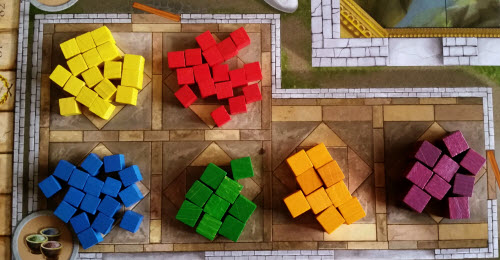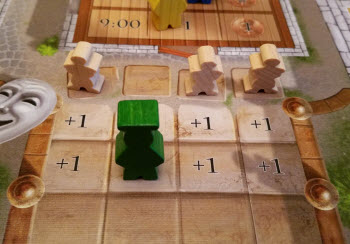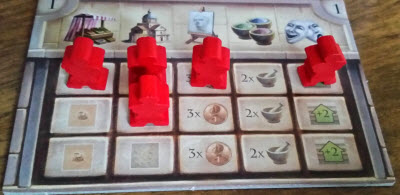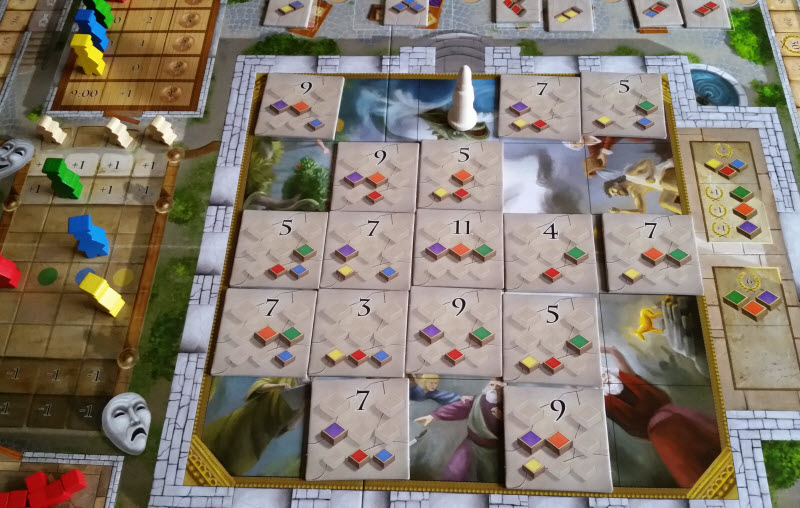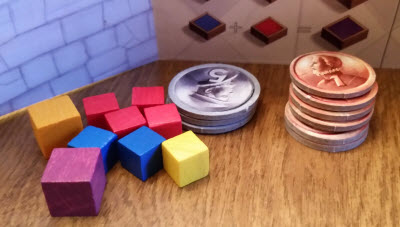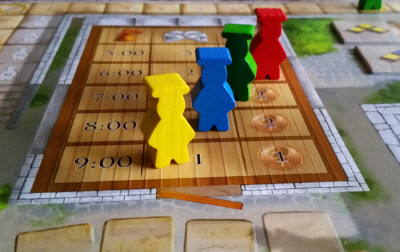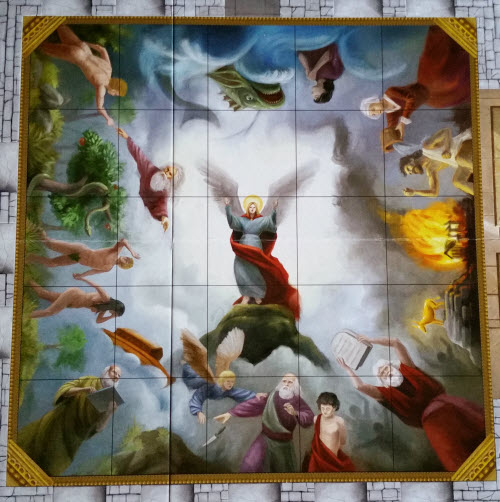Note: This review pertains to the Big Box Edition of Fresco, consisting of the base game and its 11 small expansion modules. The first page references the base game only. The second page addresses the expansions and assumes that you are familiar with the base game, or at least have read the preceding review portion.
Egregi Signore Luca,
I am most humbled and appreciative that you have accepted the task to restore our parish fresco. We would not ask of you to undertake such a trip, as we know Venice is quite far to travel for such a small enclave as ours. Alas, we lack the skills you possess to mend the damage befallen to it, especially before the summer visit of the Cardinals. As a student of Raphael’s studio, we place our trust in the masterful hands of you and your fellow artisans. We hope that with your combined help our fresco will once again be a beacon of God’s glory to the region.
Grazie in anticipo,
-Bishop Alessandro Domenico Rossellini
The Premise
The local church bishop is due to receive some very important guests in the near future and has decreed that in honor of the occasion, the church’s dilapidated fresco ceiling painting be restored. A call has gone out seeking the best fresco painters. As those painters, players must gather and mix paints in the right combinations, maintain their coffers, and keep their apprentices productive, all in an effort to ensure that they are seen as the most renown fresco painter around.
The Rules
The programmable Worker Placement game of Fresco is played out on a central board, and while there are numerous tiles and tokens, setup is rather quick. Fresco’s main resources are Thalers (money) and paint tokens. Paint comes in three primary colors (Red, Blue, Yellow) and three secondary colors (Orange, Green, Purple). Fresco also contains Market tiles, depicting paints for purchase, which are drawn randomly each round.
The board also shows, naturally, the fresco to be restored. The painting is divided into 25 segments, and the game starts with each segment covered by a fresco tile.
Players begin with player screens, some Thalers, one of each primary paint, a worker board, and five workers. These Apprentice workers are used to take various actions each round.
In Fresco, establishing turn order is a two-step process. First, players select a Wake Up spot. Wake Up spots determine the order players resolve each location. Each spot comes with a corresponding Market value and Morale modifier. High Morale can award an extra worker, while low Morale can cause a player to forfeit one. The earlier a player wakes up, the more costly the values.
For the first round, players choose Wake Up spots in a random order. In all subsequent rounds, it is determined by reverse VP total.
Next, players secretly assign Apprentices using their worker boards. Players can place up to three workers at each of the game’s five locations: Market, Cathedral, Studio, Workshop, and Theater. Once finished, the boards are revealed simultaneously.
At the Market, the player selects an available marketplace and, for each Apprentice, may purchase a paint tile to gain that many paint tokens. Alternatively, a player can forgo purchasing and close the marketplace instead by clearing all tiles from it.
Next comes the Cathedral – the center of Fresco’s premise. Here, each Apprentice may restore one fresco tile. To restore, the player removes and scores a tile from the board by spending the depicted paint colors. The Cathedral is also home to the Bishop marker, which awards bonus points if the restored tile is on or adjacent to it. An Apprentice can alternatively work the Altar, a reusable location which awards small amounts of VP.
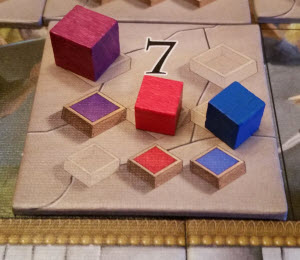
Color coded and everything!
The Studio provides players with money. For each Apprentice assigned, players collect three Thalers.
At the Workshop, each Apprentice allows the player to players mix paints together to generate up to two secondary colors.
Lastly comes the Theater, offering a respite from work. Each Apprentice at the Theater raises the player’s Morale.
Once all five locations are resolved, the round is over. Players collect residual income for each fresco tile completed, the Market is restocked, and then new round begins.
The final round is signaled when one begins with six or fewer fresco tiles remaining.
Afterwards, players convert remaining money into VP. The player with the highest VP total has shown themselves to be the most skillful, resourceful, and efficient painter in the land. Their name will become synonymous with the glory and pride of the church’s restoration, and centuries later their efforts shall be remembered mostly as an anthropomorphic turtle action figure.
Everyone else should probably just be happy the Bishop even bothered to pay them.
Closely Guarded Painting Techniques
One of the most notable things about Fresco, aside from that you’re entering a world of moderately competitive Renaissance painting, is how much hidden information the game has. Although your completed fresco tiles is public, everything else is squirreled away behind player screens. Even your actions each round are selected in private. Luckily, Fresco makes particularly effective use of all this hidden information in two key ways.
Firstly, it makes the game more fun. There’s an inherent degree of excitement when each master painter pulls back the curtain on their meticulously laid assignments for the round and you then see how it all plays out. Plus, it lends well to Fresco’s theme. It makes sense that you and your restoration team would be far too busy with your task than to immaculately know exactly how much materials and money your competitors have on hand. Indeed, Fresco does a decent job mixing its mechanics with its warm theme, and even for a worker placement game, Immersionists should find some basic interest here.
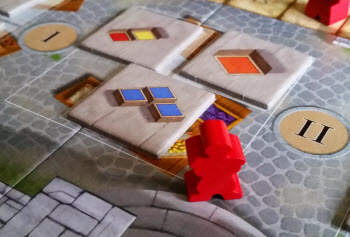
“Shut’er Down Steve!”
Second, and more importantly, it prevents the game from escalating into a giant mess of cutthroat behavior. By always knowing exactly how much money or paint everyone else had, Fresco would take on a far more competitive tone than it warrants. Players would be constantly trying to undercut one another or min/max what the absolute best move would be.
By keeping information hidden, players instead principally focus on their own plans and ambitions. While it is strategically advantageous to monitor other players on occasion, it’s not worth the hassle over long spans.
However, although a lighter game, Fresco is not devoid of aggressive tactics. For example, a player may shut down a marketplace rather than purchasing paint if they have an early Wake Up time, as to possibly hamper other players from getting needed materials.
Similarly, if you think a player is after a certain paint or fresco tile, then occasionally blocking them by taking it first is not only possible, but it’s actually a sound decision.
That being said, Strikers will feel conflicted with this game. Fresco certainly affords you room to prove your mettle against the other players, but it’s difficult to permanently impair your opponents. It’s simply not in line with the game’s temperate flavor. Indeed, one of Fresco’s greatest attributes is that there is ample room to adjust to your own mistakes, as well as interference (intentional or otherwise) from other players.
Mastering The Movable Canvas
That’s not to say that there isn’t healthy artisanal competition at work in Fresco. Quite the opposite – the strategic tug-of-war between master painters is the cornerstone of what makes Fresco work so well.
For starters, its unorthodox turn structure provides a recurring catch-up system where it’s difficult to create a runaway leader. By having the last place person pick first, it gives them and other players a means to not be shut out and keeps the leader from getting out of reach.
Yet the game doesn’t go so far as to totally punish you for being successful. Being first to select a Wake Up time doesn’t necessarily mean you’ll even want to go first. Depending on your ambitions, turn order can be incredibly important one round and inconsequential the next. (You’ll experience both sentiments.) Going first is more expensive after all, whereas going later in the day is more economical and possibly gains you access to a sixth worker. There are also tactical reasons to go later in the day – such as forcing the lead player to take an earlier spot with negative attributes, thus making their turns more costly.
That all said, going first still has significant upsides, as it ensures you access to the tiles you want. Tacticians particularly will enjoy manipulating this aspect of the game.
The resulting effect is a game where the point leader changes pretty regularly. Sometimes you may deliberately forfeit getting VP for a better Wake Up time the following round, and sometimes it’s simply because you’ve fallen behind. Either way, Fresco’s turn mechanic proves a great equalizing factor, making for a game where players are often jockeying for position right up until the final round.
Whether it’s angling for turn order, hoarding money for surprise points at the end of the game, or maximizing the benefits of the Bishop’s bonuses, this simple yet deep game provides a healthy race all the way to the end. Architects will easily enjoy Fresco’s ability to amass their paint and money behind their cardboard canvases as they plan for their masterstroke turns.
Sadly, as unpredictable as the game can be, Fresco isn’t the right palette for a Daredevil’s artistic vision. Fresco has enough unknowns via hidden information, so it wisely offsets this by having little luck in the game beyond the Market tiles. The combination of low luck and lack of alternate paths to victory will just have them feeling like a tortured soul.
The “Bischop’s” Favor?
Painting is no easy task; it can be painstakingly slow and meticulous, with attention paid to every detail. Due to the nature of how frescos work, though, there is very little time to correct mistakes. Therefore, fresco painters must work carefully to avoid them and either accept a small margin of error, or be willing to undo days of hard work to remove the problematic section. The same is true with three areas of this game.
The first is that the Big Box rulebook contains numerous small typos throughout its pages. Overall, the rules do a fantastic job walking you through how Fresco and all of its components work, and while the typos admittedly don’t affect the understanding of the rules, they do diminish from an otherwise cogent delivery.
Secondly, although the game is for 2-4 players, four is the ideal player size for Fresco. Three players is decent, although there is slightly less game tension over Wake Up choices, and a two-player game comes with extra rules baggage in the form of a semi-automated player that takes away some of the game’s elegance.
Most noteworthy is that Fresco has a very front-heavy pacing. That is, the first half of each round is full of interesting decisions as you compete over turn order, paints to buy, and which fresco tiles will be completed. This creates an enjoyably light tension as you hope that your actions go off as planned, and if not, determining how you’ll adjust.
Then it just sort of dies off. The final three locations come across as nothing more than a series of upkeep steps, where players collect money, mix paint, and maybe catch a lively theater showing. As they exist, they feel almost dragged out as three separate spaces.
On the one hand, this leaves a sense that these actions are underutilized and lackluster compared to the first half of the round, to a point where it feels like Fresco really only takes place at the Market and Cathedral. On the other hand, keeping these sections simple admittedly helps maintain its status as a light worker placement game. So much so, in fact, that between its straightforward rules and pleasant theme, Fresco proves to be a worker placement Socializers can even enjoy.
The Takeaway
From its stuffy workshop to its vaulted ceiling, Fresco puts the brush in the hands of the players and stirs up something entertaining. Fresco is a pleasantly concise thematic worker placement game that moves along as easily as paint across wet plaster. The color-centric premise is elegantly simple, making it accessible to strategists and casual gamers alike. Games are competitive and often tightly contested right until the end but never actually steps into antagonistic territory. It’s clear the desired tone is more along the lines of friendly rivalry than overt animus, and Fresco does this remarkably well. That said, Fresco can run into issues with pacing, and at times seems like it desires to offer more options than it does. Still, when stepping back and looking at the pieces as a whole, Fresco is certainly one exhibit worth viewing.
Fresco is a product of Queen Games.
Cardboard Republic Snapshot Scoring for the base game of Fresco (Based on scale of 5):
Artwork: 4
Rules Clarity: 4.5
Replay Value: 4
Physical Quality: 4
Overall Score: 4

